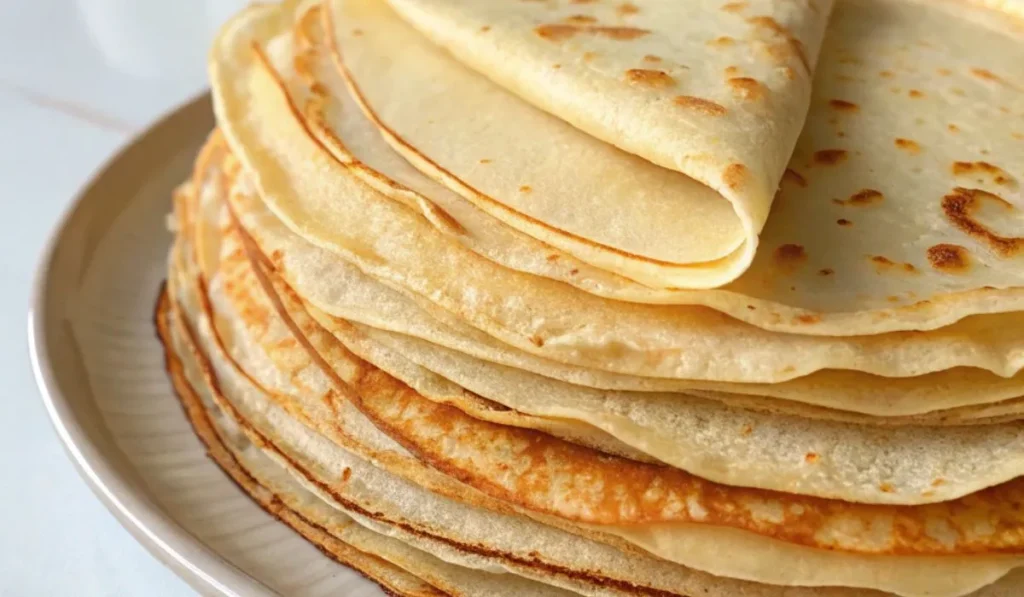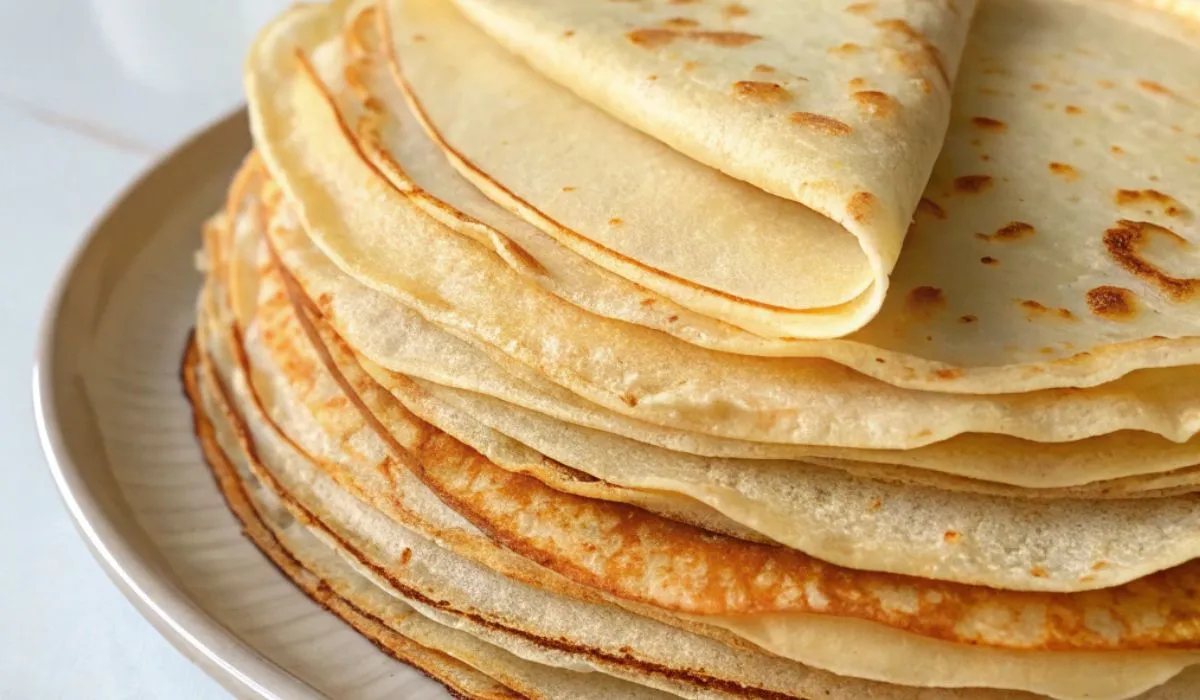This easy crepe recipe makes it simple to whip up light, golden crepes at home—even if your first try isn’t perfect.
When I first made crepes over ten years ago, the batter was clumpy and the results weren’t pretty.
But after lots of practice, I realized crepes are actually pretty easy once you know a few simple tips.
With this recipe, you’ll be making perfect crepes in no time.

What Are Crepes
Crêpes are very thin pancakes from 13th-century France. Don’t let the fancy name scare you. These delicate treats use basic ingredients you probably have right now. They’re surprisingly simple once you get the right technique.
What makes crêpes so great is how you can use them. I’ve found they’re like blank canvases. You can make sweet breakfast treats with fresh berries and cream, or savory dinner options with cheese, vegetables, and proteins. I’ve served them at fancy brunch parties and casual family breakfasts. They always impress.
The Secret Behind Perfect Crepe Batter
Before we start cooking, let me share something important I learned: the secret to perfect crêpes is understanding your batter. Unlike thick pancake batter, crêpe batter should be smooth and thin. It needs to spread easily across your pan.
The key is getting the right balance of liquid to flour. Then (this is crucial) you let the batter rest.
When I first started making crêpes, I was impatient. I skipped the resting time. Big mistake!
Resting the batter for at least 30 minutes (I like overnight better) lets the gluten relax. The flour gets fully hydrated too. This makes tender, flexible crêpes that won’t tear when you flip them.
What You Need for Basic Crepes
The best part about this crêpe recipe is how simple it is. You need just six basic ingredients:
The Foundation (makes 8 crêpes):
- 2 large eggs (fresh eggs work better)
- 1/2 cup milk (I use 2% milk for the right richness)
- 1/2 cup water (this thins the batter for that delicate texture)
- 1/4 teaspoon salt (makes all the flavors better)
- 1 cup all-purpose flour (sift it if you want extra smoothness)
- 2 tablespoons butter, melted (adds richness and stops sticking)
For sweet crêpes, add:
- 1 tablespoon granulated sugar
- 1 teaspoon vanilla extract
I’ve found this ratio creates perfect batter. It’s thin enough to spread easily but thick enough to hold together beautifully.
How to Make Perfect Crepes Step by Step
1. Making the Batter
Method 1: Blender Way (I like this best)
- Put all ingredients in your blender in this order: milk, water, eggs, salt, flour, and cooled melted butter
- Blend for 15-20 seconds until completely smooth
- The batter should look like heavy cream
Method 2: Whisk Way
- In a large bowl, whisk together eggs, milk, water, and salt
- Add flour slowly, whisking hard to stop lumps
- Whisk in the melted butter until smooth
The Rest Period (Don’t Skip This!) Put your batter in a covered container. Refrigerate for at least 30 minutes. I often make my batter the night before. This longer resting time makes even better results.
2. Cooking Your Crêpes
This is where the magic happens. Here’s exactly how I do it:
- Heat your pan: Use an 8-inch non-stick pan over medium-low heat. Temperature matters a lot. Too hot and your crêpes cook too fast and get tough.
- Pour and swirl: Pour about 1/4 cup batter into the center of your heated pan. Right away, lift the pan off the heat. Tilt it in a circle so the batter spreads evenly to the edges. This should take just 2-3 seconds.
- Cook the first side: Put the pan back on heat. Cook for 1-2 minutes until the edges look set and the bottom is light golden brown.
- Flip it: Here’s my way. Run a thin spatula around the edges to loosen the crêpe. Then slide it under and flip quickly. Don’t worry if your first few aren’t perfect. I still get tears sometimes!
- Cook the second side: Cook for another 30 seconds to 1 minute until lightly browned.
- Stack and keep warm: Move to a plate and stack your finished crêpes. You can keep them warm in a 175°F oven if you need to.
My Best Tips for Crepe Success
After making thousands of crêpes over the years, here are my most helpful tips:
- Watch the temperature: If your first crêpe is too thick, your pan might be too cool. If it cooks too fast or seems tough, turn down the heat.
- Check batter thickness: The batter should coat the back of a spoon but still drip off easily. If it’s too thick, whisk in a tablespoon of milk or water.
- The first crêpe rule: Don’t judge how you’re doing by the first crêpe. It’s often not perfect as the pan finds its right temperature. I call it the “practice crêpe”!
- Speed matters: The key to thin, even crêpes is being fast. Pour and tilt right away. Wait too long, and you’ll get thick spots.
Amazing Ways to Fill and Serve Crepes
This is where crêpes really shine. In my kitchen, we’ve tried so many combinations:
Sweet Options I Love:
- Classic French: Just dust with powdered sugar and add a squeeze of lemon
- Berries and cream: Fresh strawberries, whipped cream, and honey
- Chocolate treat: Nutella, sliced bananas, and chopped hazelnuts
- Apple cinnamon: Sautéed apples with cinnamon and crème fraîche
Savory Favorites:
- Ham and Gruyère: A classic French mix that always works
- Spinach and mushroom: Sautéed with garlic and finished with Parmesan
- Breakfast crêpe: Scrambled eggs, crispy bacon, and sharp cheddar
How to Store and Make Ahead
One thing I love about crêpes is how well they keep:
- In the fridge: Stack cooled crêpes with wax paper between each one. Put them in an airtight container. They’ll stay good for up to 3 days.
- In the freezer: Crêpes freeze really well for up to 2 months. I often make double batches and freeze half for quick breakfasts.
- Reheating: Warm gently in a skillet over low heat, in the microwave for 10-15 seconds, or in a 175°F oven for 5 minutes.
Fixing Common Crêpe Problems
- Crêpes are too thick: Your batter needs more liquid, or your pan temperature is too low.
- Crêpes are tearing: The batter might be too thin, or you didn’t let it rest long enough.
- Uneven cooking: Make sure you tilt the pan right after pouring. Check that your heat stays steady.
- Sticking to the pan: Make sure your pan is heated properly and lightly greased. Non-stick pans work best.
Why This Recipe Works Every Time
What makes this crêpe recipe so reliable is the perfect balance of ingredients and method. The mix of milk and water creates the right texture. It’s not too rich, not too thin. The resting period gives you tender results. The cooking method I’ve shared comes from years of testing and improving.
I’ve taught this recipe to dozens of home bakers. Complete beginners and experienced cooks both get beautiful results. The key is understanding that making crêpes is about technique as much as ingredients.
Ever wondered why some crêpe recipes fail? It’s usually because people rush the process or don’t get the batter consistency right. This recipe fixes those common problems.
FAQs
Yes, you can make eggless crêpes! I’ve tried this for friends with egg allergies. Replace the 2 eggs with 1/2 cup of unsweetened applesauce or 2 tablespoons of ground flaxseed mixed with 6 tablespoons of water (let it sit for 5 minutes until thick). The texture will be slightly different but still delicious. You might need to add an extra tablespoon of flour to get the right consistency.
Crêpes are much thinner than pancakes and don’t use baking powder or baking soda. Pancakes are fluffy because of the leavening agents, while crêpes are thin and flexible. Crêpe batter is also much more liquid than pancake batter. Think of crêpes as the elegant French cousin of pancakes. They’re meant to be rolled or folded with fillings, while pancakes are usually stacked and topped.
You can experiment with different flours, but the results will vary. I’ve tried whole wheat flour (use 3/4 cup instead of 1 cup all-purpose flour and add 2 extra tablespoons of liquid). Almond flour works too, but use only 3/4 cup and expect a more delicate, nutty-flavored crêpe. Gluten-free flour blends work well if you let the batter rest for at least an hour. Rice flour makes very thin, crispy crêpes that are perfect for savory fillings.
This usually happens when your batter has air bubbles or your pan is too hot. To fix this: First, let your batter rest longer (bubbles will settle). Second, strain the batter through a fine mesh sieve before cooking. Third, lower your heat slightly. If you’re whisking by hand instead of using a blender, whisk more gently to avoid creating too much air. I’ve found that overnight-rested batter almost never has this problem.
Conclusion
Making perfect homemade crêpes isn’t just about following steps. It’s about understanding the process and enjoying the practice.
Yes, your first few might not look like café crêpes, but each one you make teaches you something.
You’ll develop the feel for the batter, the timing, and the technique that turns simple ingredients into something special.
Start with this basic recipe and then make it your own. Try different fillings. Test sweet and savory options. Most importantly, enjoy the process. There’s something really satisfying about creating these delicate, golden circles in your own kitchen.
Now grab your pan and get started. Your first perfect crêpe is waiting!
What filling will you try first? I’d love to hear about your crêpe adventures in the comments below.

Homemade Crepe Recipe
Ingredients
Equipment
Method
- Make the batter: In a blender, combine milk, water, eggs, salt, flour, and melted butter. Blend for 15-20 seconds until completely smooth. Alternatively, whisk ingredients together in a large bowl, adding flour gradually to prevent lumps.
- Rest the batter: Transfer batter to a covered container and refrigerate for at least 30 minutes (preferably overnight) to allow gluten to relax.
- Heat the pan: Heat an 8-inch non-stick frying pan over medium-low heat. Lightly grease if needed.
- Cook the crêpes: Pour 1/4 cup batter into the center of the hot pan. Immediately lift the pan and tilt in a circular motion to spread batter evenly to edges.
- First side: Cook for 1-2 minutes until edges are set and bottom is lightly golden brown.
- Flip: Run a spatula around edges to loosen, then flip carefully. Cook second side for 30 seconds to 1 minute until lightly browned.
- Stack and serve: Transfer to a plate and stack finished crêpes. Serve immediately with desired fillings or keep warm in 175°F oven.
